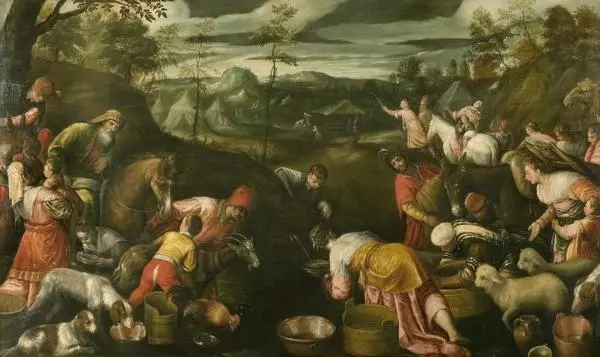This painting was created in the workshop of Jacopo Bassano – one of the best-known masters of the Renaissance. The real name of the artist was Dal Ponte. Bassano was a nickname based on the name of the city where he was born.
The artist received his artistic training from his father, and then from the artist Bonifacio di Pitati from Venice. After that, he came back to his home city and opened his own workshop. The apprentices and numerous relatives of Bassano worked there. According to various sources, his works were of high demand, and the workshop hardly managed the numerous orders.
Bassano was a representative of the Venetian school of painting. It emerged in the middle of the 14th century, but specialists consider the period from the 15th to the 16th century to be its Golden Age. The characteristic features of this school is bright color palette and interest in the plastic capabilities of a human body.
Alexander Benois, the critic, called Bassano the great admirer of nature. The artist often depicted people and animals surrounded by plants. He painted wild animals and birds from life, because he wanted them to look plausible on his paintings. He often combined the flora and fauna depictions with the Bible scenes.
The story of Noah from the Old Testament was especially attractive for Bassano. Several paintings dedicated to this topic were created in his workshop, including a series of four paintings: Building Noah’s Ark, Animals Boarding Noah’s Ark, The Great Flood, Noah’s Offering. All of them became very popular and were often copied.
As per the Scripture text, the Lord plagued the Great Flood for people’s depravity and malice. It was raining for forty days and nights, and the earth was covered with water. Noah and his family were righteous and honest people, so they were offered the salvation. The Lord told them to build a wooden ark and to take two of every kind of the animals.
Bassano depicted the culmination of the Bible story – the Ark is finished, and the animals are boarding in pairs. Noah’s family is filling the Ark with various supplies. The artist placed the entrance to the Ark in the background on the right. Noah’s wife is standing in the doorway and greeting wild animals. Noah himself is kneeled by the wooden deck. Other figures in the painting are Noah’s sons and daughters in law helping with the preparations.
Radishchev Museum received the painting in 1885 from the Imperial Hermitage in St.-Petersburg.
The artist received his artistic training from his father, and then from the artist Bonifacio di Pitati from Venice. After that, he came back to his home city and opened his own workshop. The apprentices and numerous relatives of Bassano worked there. According to various sources, his works were of high demand, and the workshop hardly managed the numerous orders.
Bassano was a representative of the Venetian school of painting. It emerged in the middle of the 14th century, but specialists consider the period from the 15th to the 16th century to be its Golden Age. The characteristic features of this school is bright color palette and interest in the plastic capabilities of a human body.
Alexander Benois, the critic, called Bassano the great admirer of nature. The artist often depicted people and animals surrounded by plants. He painted wild animals and birds from life, because he wanted them to look plausible on his paintings. He often combined the flora and fauna depictions with the Bible scenes.
The story of Noah from the Old Testament was especially attractive for Bassano. Several paintings dedicated to this topic were created in his workshop, including a series of four paintings: Building Noah’s Ark, Animals Boarding Noah’s Ark, The Great Flood, Noah’s Offering. All of them became very popular and were often copied.
As per the Scripture text, the Lord plagued the Great Flood for people’s depravity and malice. It was raining for forty days and nights, and the earth was covered with water. Noah and his family were righteous and honest people, so they were offered the salvation. The Lord told them to build a wooden ark and to take two of every kind of the animals.
Bassano depicted the culmination of the Bible story – the Ark is finished, and the animals are boarding in pairs. Noah’s family is filling the Ark with various supplies. The artist placed the entrance to the Ark in the background on the right. Noah’s wife is standing in the doorway and greeting wild animals. Noah himself is kneeled by the wooden deck. Other figures in the painting are Noah’s sons and daughters in law helping with the preparations.
Radishchev Museum received the painting in 1885 from the Imperial Hermitage in St.-Petersburg.




